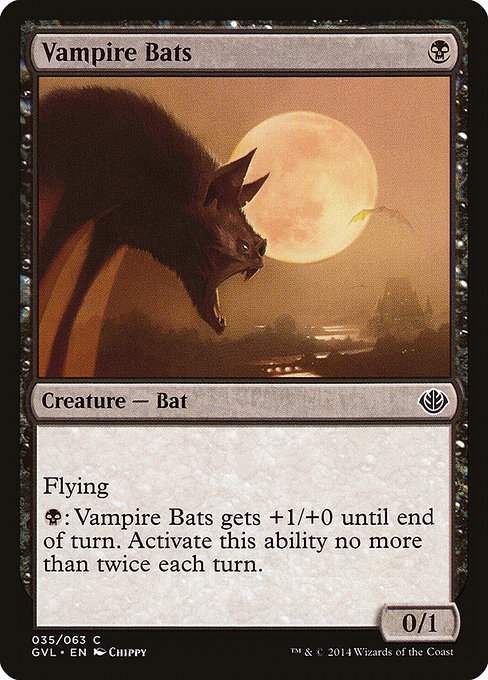
Image courtesy of Scryfall.com
Mastering Sequencing and Subtle Power with Vampire Bats
If you’ve ever piloted a lean black tempo plan, Vampire Bats feels like a wink from the shadows—small, unassuming, but capable of delivering precise, punchy plays when you sequence correctly. This 1-mana black creature from the Duel Decks Anthology: Garruk vs. Liliana (GVL) arrives as a humble 0/1 flyer with an activated pump that costs one black mana. The real magic isn’t its base stats; it’s how you choreograph its two optional power boosts across a single turn. 🧙♂️🔥
Vampire Bats is a common creature with flying, a trait that instantly elevates its value in many black archetypes. The built-in evasion lets it threaten for damage where ordinary ground blockers fail to apply pressure, especially in creature-light environments or against decks that rely on resilient blockers. The true sequencing edge comes from the activated ability: pay B to give Vampire Bats +1/+0 until end of turn, with the caveat that you can activate this ability no more than twice per turn. That means, in a single turn, you can push the bat from a timid 0/1 into something far more threatening—2/1, if you pump twice—without ever overcommitting mana. ⚔️
Think of sequencing as a mini-puzzle: when do you invest mana to push through damage, and when do you hold back to protect the creature from removal? The answer changes with your opponent’s board, your available mana, and the tempo of the game. If you’re facing an opponent with a single blocking creature that’s just shy of lethal, a timely two-pump on Vampire Bats can turn a potential chump block into a clean two-point hit, or even force a trade that leaves you ahead on board presence. The timing matters as much as the number of pumps. A pre-combat pump can clear a path by increasing post-damage pressure, while a post-combat pump can salvage a situation where combat taps out your opponent’s defenses. 🧙♂️💎
In terms of deck design, Vampire Bats shines in mono-black and red-black tempo shells, where you want cheap threats that fly and can be boosted on demand. The card’s rarity (common) and its reprint history in a Duel Deck make it both approachable for newer players and a nostalgic nod for longtime fans who remember the Garruk vs. Liliana pairing. The lore you bring to the table—vampire mythos, night-bound predation, and the classic black emphasis on efficiency and disruption—pairs nicely with the card’s practical sequencing. In practice, you might hold a pump trick for a moment where your opponent overextends, turn a single mana into immediate pressure, and keep a reserve to respond to a removal spell or a blocking force. 🎨
Let’s sketch a few concrete sequencing scenarios to illustrate the concept. Scenario A: Early pressure with a single-bump plan. Play Vampire Bats on turn 1 or 2, then hold both B mana pumps for a potential combat trick on turn 4. If the board is quiet, you can contribute a surprise 2/1 flyer by pumping twice during combat, turning a marginal board into a real threat. Scenario B: Surviving removal while maintaining tempo. If your opponent has targeted removal, you can deploy the bats as a flying clock, pump once to threaten early damage, and hold the second pump for when the creature is likely to be blocked or removed—forcing a decision where your opponent spends resources to answer a 2/1 flier instead of your other threats. Scenario C: Backbreaking reach with skirmish goes long. Against a deck with a barrage of small blockers, landing two pumps across two turns can make Vampire Bats a persistent source of incremental damage that wears down an opponent’s life total, especially when paired with other evasive creatures. 🧙♂️⚔️
Art and design choices around Vampire Bats also reflect the elegance of the GVL set. The black frame and clean linework emphasize the creature’s nocturnal vibe, and the straightforward, no-nonsense ability text makes it a satisfying card to read aloud during a game-night chat. The simplicity of the card’s mana cost—one black mana—pairs well with the idea of efficient, well-timed events that yield outsized results. For collectors and players who appreciate the tactile joy of minimalism, a well-timed two-pump sequence feels almost cinematic—the kind of small victory that sticks in the memory as much as in the game state. 💎
For players who love exploring the broader MTG ecosystem, Vampire Bats offers an approachable entry point into the deeper art of sequencing. It’s not a game-breaking bomb, but it rewards crowd-sourced wisdom and careful practice. The card’s presence in a Duel Deck—paired against Liliana’s archetypes and Garruk’s feral ramp—also invites conversations about how color pairs influence tempo and resource management. If you’re a new player, try a few test runs with a single-B pump line on your flying 0/1 to see how your opponent responds to evasion and pressure. If you’re a veteran, think about how this tiny bat can interact with a broader suite of black removal, discard, or recursion to keep your clock ticking while you build a board state that compels your opponent to react. 🧙♂️🎲
As you polish your sequencing, a small, stylish companion can help you carry that MTG passion off the battlefield too. If you’re in the market for gear that nods to the hobby, consider the Neon Card Holder Phone Case MagSafe Polycarbonate—an eye-catching little accessory that neatly fits your play-at-home or travel game nights. It’s a subtle reminder that the cards we love aren’t just about power on the table—they’re about the rituals, the conversations, and the small joys that come with a well-timed attack or a perfectly-timed bluff. The product page links are just a click away, ready to ride along with your next trip to the plane of your choice. 🔥🎨
Neon Card Holder Phone Case MagSafe PolycarbonateMore from our network
- https://blog.rusty-articles.xyz/blog/post/exploring-murkrow-holofoil-texture-and-depth-across-variants/
- https://blog.zero-static.xyz/blog/post/what-flow-of-maggots-teaches-about-creative-mtg-play/
- https://crypto-acolytes.xyz/blog/post/unlocking-secrets-of-medieval-castles-in-open-world-games/
- https://blog.rusty-articles.xyz/blog/post/trust-through-transparent-design-open-port-clear-silicone-phone-case/
- https://crypto-acolytes.xyz/blog/post/minecraft-grindstone-guide-repair-disenchant-and-enchantments/